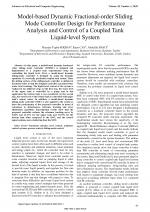| 3/2020 - 11 | View TOC | « Previous Article | Next Article » |
Model-based Dynamic Fractional-order Sliding Mode Controller Design for Performance Analysis and Control of a Coupled Tank Liquid-level SystemSEKBAN, H. T. |
| Extra paper information in |
| Click to see author's profile in |
| Download PDF |
Author keywords
fractional calculus, level control, nonlinear control systems, process control, sliding mode control
References keywords
control(25), sliding(15), mode(13), fractional(11), controller(11), tank(9), level(9), liquid(8), coupled(8), basci(8)
Blue keywords are present in both the references section and the paper title.
About this article
Date of Publication: 2020-08-31
Volume 20, Issue 3, Year 2020, On page(s): 93 - 100
ISSN: 1582-7445, e-ISSN: 1844-7600
Digital Object Identifier: 10.4316/AECE.2020.03011
Web of Science Accession Number: 000564453800011
SCOPUS ID: 85090360900
Abstract
In this paper, a model-based dynamic fractional-order sliding mode controller (FOSMC) is designed and implemented to a coupled tank experimental setup for controlling the liquid level. First, a model-based dynamic sliding-mode controller is designed by using the dynamic equations of a vertically positioned coupled tank system. Then, the sliding surface of the sliding-mode controller is defined in fractional order so that the designed controller can make better water level tracking. The liquid level control of the system is realized in two different steps. In the first step, the water level of the upper tank is controlled by a pump and in this application the bottom tank is not considered. In the second step, the water level of the bottom tank is controlled with upper tank's output water. In addition, a model-based dynamic sliding mode controller (SMC) is also applied to the system to show the performance of the proposed controller in terms of robustness to disturbances, reference tracking and error elimination capability. Experimental results show that the proposed controller reduces the reference tracking error by 3.68% and 10.17% for the upper tank and 17.07% for the bottom tank when compared to the SMC, and the control signal contains more chattering than the SMC. |
| References | | | Cited By |
Web of Science® Times Cited: 5 [View]
View record in Web of Science® [View]
View Related Records® [View]
Updated today
SCOPUS® Times Cited: 5
View record in SCOPUS® [Free preview]
View citations in SCOPUS® [Free preview]
[1] Hybrid Optimization of Controller for Multi-variable System, Nagarajapandian, M., Kanthalakshmi, S., Journal of Electrical Engineering & Technology, ISSN 1975-0102, Issue 3, Volume 19, 2024.
Digital Object Identifier: 10.1007/s42835-023-01605-w [CrossRef]
[2] PI+Feed Forward Controller Tuning Based on Genetic Algorithm for Liquid Level Control of Coupled-Tank System, YILMAZ, Mehmet, CAN, Kaan, BAŞÇİ, Abdullah, Iğdır Üniversitesi Fen Bilimleri Enstitüsü Dergisi, ISSN 2536-4618, Issue 2, Volume 11, 2021.
Digital Object Identifier: 10.21597/jist.819389 [CrossRef]
[3] A Water Tank Level Control System with Time Lag Using CGSA and Nonlinear Switch Decoration, Xu, Weifeng, Zhang, Xianku, Wang, Haoze, Applied System Innovation, ISSN 2571-5577, Issue 1, Volume 6, 2023.
Digital Object Identifier: 10.3390/asi6010012 [CrossRef]
[4] Comparison of the Performance of Type-1 and Interval Type-2 Fuzzy PI Controllers for Liquid Level Control in a Coupled Tank System, Nursoy, Hatice, Başçi, Abdullah, Erzincan Üniversitesi Fen Bilimleri Enstitüsü Dergisi, ISSN 2149-4584, Issue 2, Volume 17, 2024.
Digital Object Identifier: 10.18185/erzifbed.1508424 [CrossRef]
[5] Designing New Model-Based Adaptive Sliding Mode Controllers for Trajectory Tracking Control of an Unmanned Ground Vehicle, Sekban, Hayriye Tugba, Basci, Abdullah, IEEE Access, ISSN 2169-3536, Issue , 2023.
Digital Object Identifier: 10.1109/ACCESS.2023.3313942 [CrossRef]
[6] Lyapunov‐based adaptive state‐space controller for liquid level control of a coupled tank system with unknown model, Lotfieghlim, Armin, Sekban, Hayriye Tuğba, Başçi, Abdullah, The Canadian Journal of Chemical Engineering, ISSN 0008-4034, 2025.
Digital Object Identifier: 10.1002/cjce.25659 [CrossRef]
Disclaimer: All information displayed above was retrieved by using remote connections to respective databases. For the best user experience, we update all data by using background processes, and use caches in order to reduce the load on the servers we retrieve the information from. As we have no control on the availability of the database servers and sometimes the Internet connectivity may be affected, we do not guarantee the information is correct or complete. For the most accurate data, please always consult the database sites directly. Some external links require authentication or an institutional subscription.
Web of Science® is a registered trademark of Clarivate Analytics, Scopus® is a registered trademark of Elsevier B.V., other product names, company names, brand names, trademarks and logos are the property of their respective owners.
Faculty of Electrical Engineering and Computer Science
Stefan cel Mare University of Suceava, Romania
All rights reserved: Advances in Electrical and Computer Engineering is a registered trademark of the Stefan cel Mare University of Suceava. No part of this publication may be reproduced, stored in a retrieval system, photocopied, recorded or archived, without the written permission from the Editor. When authors submit their papers for publication, they agree that the copyright for their article be transferred to the Faculty of Electrical Engineering and Computer Science, Stefan cel Mare University of Suceava, Romania, if and only if the articles are accepted for publication. The copyright covers the exclusive rights to reproduce and distribute the article, including reprints and translations.
Permission for other use: The copyright owner's consent does not extend to copying for general distribution, for promotion, for creating new works, or for resale. Specific written permission must be obtained from the Editor for such copying. Direct linking to files hosted on this website is strictly prohibited.
Disclaimer: Whilst every effort is made by the publishers and editorial board to see that no inaccurate or misleading data, opinions or statements appear in this journal, they wish to make it clear that all information and opinions formulated in the articles, as well as linguistic accuracy, are the sole responsibility of the author.



